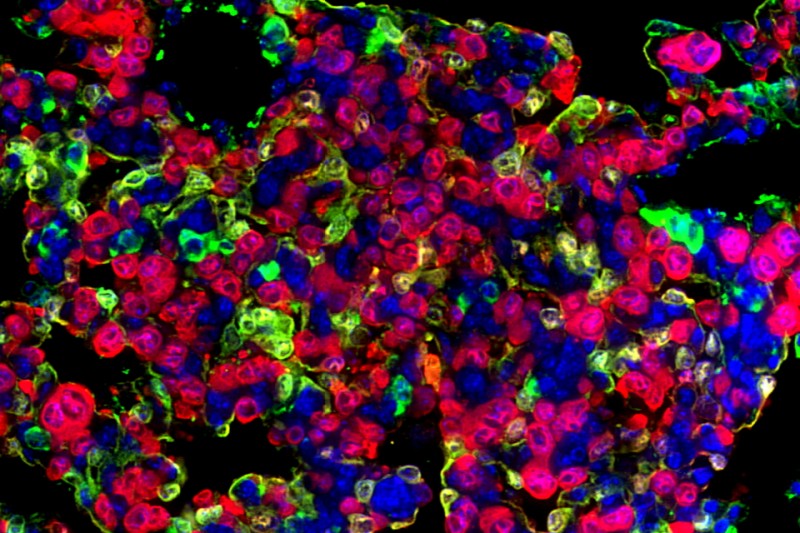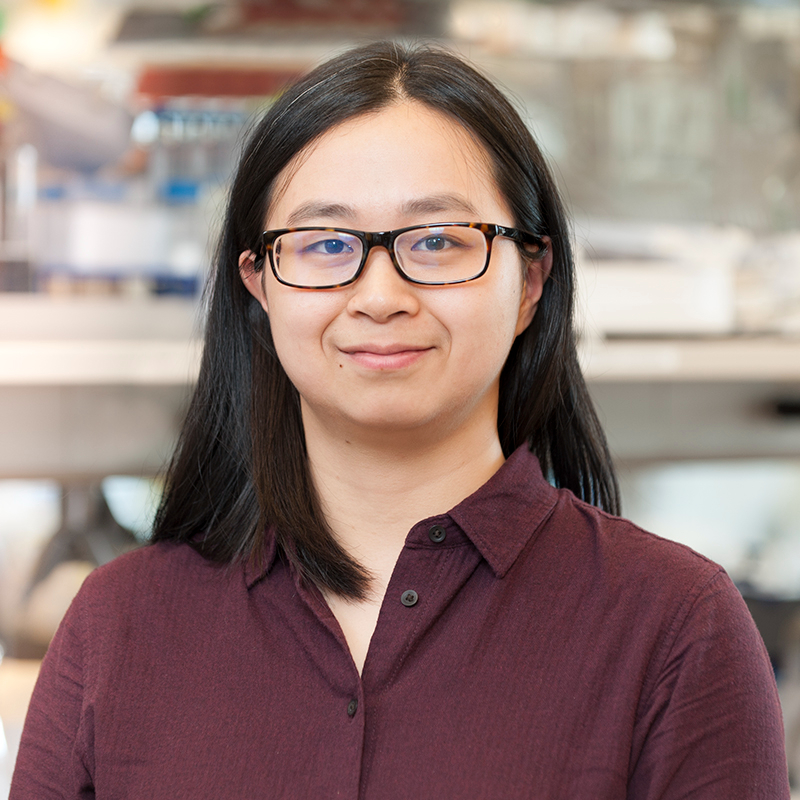
Lung cancer cells (red) in the mouse lung adapt to KRAS inhibition (green). This adaptation allows the cells to withstand KRAS inhibitor therapy and can give rise to lung cancer resurgence later on.
A new understanding of lung cancer cells’ “memories” suggests a new strategy for improving treatment, Memorial Sloan Kettering Cancer Center (MSK) researchers have found.
Research from the lab of cancer biologist Tuomas Tammela, MD, PhD shows that some lung cancer cells retain a “memory” of the healthy cell where they came from — one that might be exploited to make an emerging type of lung cancer treatment called KRAS inhibition more effective.
The study looked specifically at lung adenocarcinoma, a type of non-small cell lung cancer that is the most common type of lung cancer in the U.S. and responsible for 7% of all cancer deaths. This cancer is frequently driven by mutations in the KRAS gene.

Zhuxuan “Zoe” Li
“For a long time, cancer-driving KRAS proteins were considered ‘undruggable,’” says study co-first author Zhuxuan “Zoe” Li, a doctoral student in the Tammela Lab at MSK’s Sloan Kettering Institute. “Within the last few years, however, the U.S. Food and Drug Administration approved the first KRAS inhibitors, with quite a few more in clinical trials. But they don’t work for everyone, and most patients’ cancers eventually acquire resistance to the drugs and come back.”
The team’s findings — co-led by postdoctoral fellow Xueqian Zhuang, PhD — shed important light on lung cancer cells that linger after treatment with a KRAS inhibitor. Importantly, they suggest that separately targeting these cells alongside treatment with a KRAS inhibitor could help prevent recurrence. The study was recently published in Cancer Discovery, a leading journal for biological insights that have important implications for clinical care.
‘Stem Cells With a Day Job’
To understand the MSK discovery and its implications, it’s helpful to know a little lung biology.

Dr. Tuomas Tammela
Within the lungs, oxygen is absorbed and carbon dioxide released via air sacs called alveoli. The lining of the alveoli is made of two distinct types of cells — alveolar type 1 (AT1) and alveolar type 2 (AT2).
And while they’re similarly named, these two cells couldn’t be more different.
AT1 cells are long and thin, with a large surface to facilitate gas exchange between the lungs and the bloodstream.
AT2 cells, meanwhile, play a caretaking role, secreting compounds that are important for the health and function of the lungs, as well as helping maintain and repair the lungs by dividing to create replacement AT1 cells.
“You can think of them as stem cells with a day job,” Dr. Tammela says.
The big problem comes when lung cancer cells — which typically develop from AT2 cells — take on some “remembered” properties of the AT1 cells that AT2 cells differentiate into when they’re playing their stem cell role. Scientists call these cancer cells “AT1-like” cells.
Eliminating AT1-Like Cells Improves Response to KRAS Inhibition
In healthy cells, KRAS plays a key role in regulating cell growth and division. But when the gene becomes mutated, it can lead to runaway cell proliferation.
KRAS inhibitors can switch off this explosive growth, greatly diminishing tumors, but they still leave behind pockets of cancer cells that aren’t sensitive to the drug, and that also give the cancer a chance to develop new mutations to resist the drugs’ effects.
The research team painstakingly studied these residual cancer cells to uncover the mechanisms of this resistance using genetically engineered mouse models, mice implanted with patient-derived tumors, and tumor samples from patients.
They discovered that the cancer cells that remained after treatment were these AT1-like cells. They also found these cells have the capacity to reignite the cancer’s runaway growth.
“Importantly, we found that if you get rid of these AT1-like cells, it greatly improves the treatment response to KRAS inhibitors,” Dr. Tammela says.
Eliminating those cells in experimental models is relatively easy, but doing so in the clinic will require further research.
“We actually live in a very exciting time with fantastic pharmacology,” Dr. Tammela says. “We can engineer molecules to bind to a certain cell type and kill them — this is how CAR T cell therapy and antibody drug conjugates work.
“Now that we’ve done these proof-of-concept experiments, the next step would be to find surface proteins that are unique to these AT1-like cells and then develop a therapeutic that can bind to them and kill them,” he adds.
Only at a Place Like MSK
Collaborations with other labs were essential to the research, Dr. Tammela says.

Dr. Xueqian Zhuang
“This is the type of research that can really only happen at a place like MSK,” he says. “We had really important collaborations with other labs at MSK that shared animal models and patient samples that were integral to the study, and we worked closely with several of MSK’s core facilities — the Antitumor Assessment Core, Integrated Genomics Operation, Flow Cytometry Core, and Molecular Cytology Core.”
MSK investigators Scott Lowe, PhD and Charles Rudin, MD, PhD were key contributors, Dr. Tammela notes.
“And the study would not have been possible without Zoe’s dedication, and the model systems and initial insights developed by Dr. Zhuang,” he adds.
Additional Authors, Funding, and Disclosures
Additional authors include Chun-Hao Pan, Yan Yan, Rohit Thummalapalli, Stefan Torborg, Anupriya Singhal, Jason Chang, and Rona Yaeger of MSK; Simon Joost, formerly of MSK and now at GC Therapeutics; Eusebio Manchado, formerly of MSK, now at the Novartis Institute for Biomedical Research; Jill Hallin and James Christensen of Mirati Theraputics; and Lukas Dow of Weill Cornell Medicine.
The work was supported by an American Cancer Society Research Scholar Grant (R01-CA270116), the National Institutes of Health and National Cancer Institute (R01-CA233944, P30-CA08748, F30-CA254120, T32GM007739), the Howard Hughes Medical Institute, New York Stem Cell Science (C32559GG), Hope Funds for Cancer Research, and a Josie Robertson Scholarship.
Dr. Tammela reports an advisory role and equity interests in Lime Therapeutics; and he receives research support to his laboratory from Ono Pharmaceuticals (unrelated to this work). Dr. Rudin consults on oncology drug development with AbbVie, Amgen, AstraZeneca, D2G, Daiichi Sankyo, Epizyme, Genentech/Roche, Ipsen, Jazz, Kowa, Lilly, Merck, and Syros; he also serves on the scientific advisory boards of Auron, Bridge Medicines, Earli, and Harpoon Therapeutics. Dr. Lowe is a founder and member of the scientific advisory board of Blueprint Medicines, Mirimus, ORIC Pharmaceuticals, and Faeth Therapeutics; he also has advisory role and equity interests in Constellation Pharmaceuticals and PMV Pharmaceuticals. Dr. Yaeger has served as an advisor for Amgen, Array BioPharma/Pfizer, Mirati Therapeutics, and Zai Lab; she has received research support from Array BioPharma/Pfizer, Boehringer Ingelheim, Daiichi Sankyo, and Mirati Therapeutics.